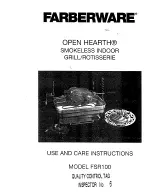
/
11
INSTALLATION
Flushing and Water Treatment
The boiler is equipped with a stainless steel heat exchanger.
The detailed recommendations for water treatment are given in BS
7593:2006 (Treatment of water in domestic hot water central heating
systems); the following notes are given for general guidance.
If the boiler is installed on an existing system, any unsuitable
additives must be removed.
Under no circumstances should the boiler be fired before the system
has been thoroughly flushed; the flushing procedure must be in line
with BS 7593:2006.
We highly recommend the use of a flushing detergent appropriate
for the metals used in the circuit. These include cleansers produced
by Fernox BetzDearbon, whose function is to disolve any foreign
matter that may be in the system.
In hard water areas or where large quantities of water are in the
system the treatment of water to prevent premature scaling of the
main exchanger is necessary.
The formation of scale heat compromises the efficiency of the
thermic exchanger because small areas of scale cause a high
increase of the temperature of the metallic walls and therefore add
to the thermal stress of the heat exchanger.
Demineralised water is more aggressive so in this situation it is
necessary to treat the water with an appropriate corrosion inhibitor.
Any treatment of water by additives in the system for frost protection
or for corrosion inhibition has to be absolutely suitable for all metals
used in the circuit.
The use of a corrosion inhibitor in the sysem such as Fernox MB-
1, BetzDearborn Sentinel X100 or Fernox System Inhibitor is
recommended to prevent corrosion (sludge) damaging the boiler
and system;
If anti-freeze substances are to be used in the system, check carefully
that they are compatible with the metals used in the circuit.
ARISTON suggests the use of suitable anti-freeze products such as
Fernox ALPHI 11, which will prevent rust and incrustation taking
place.
Periodically check the pH balance of the water/anti-freeze mixture
of the boiler circuit and replace it when the amount measured is out
of the range stipulated by the manufacturer (7 < pH < 8).
DO NOT MIX DIFFERENT TYPES OF ANTI-FREEZE
In under-floor systems, the use of plastic pipes without protection
against penetration of oxygen through the walls can cause corrosion
of the systems metal parts (metal piping, boiler etc), through the
formation of oxides and bacterial agents.
To prevent this problem it is necessary to use pipes with an “oxygen
proof barrier”, in accordance with standards DIN 4726/4729. If pipes
of this kind are not used, keep the system separate by installing
heat exchangers of those with a specific system water treatment.
IMPORTANT
Failure to carry out the water treatment procedure will invalidate
the appliance guarantee.
System Controls
The boiler is electrically controlled and is suitable for most modern
electronic time and temperature controls. The addition of such
external controls can be beneficial to the efficient operation of the
system.
The boiler connections for external controls are 240V. ARISTON
supply a range of wired and wireless system controls. Contact your
supplier for more details.
Location
The boiler can be installed on any suitable internal wall (suitable
sound proofing may be required when installing onto a stud
partition wall). Provision must be made to allow for the correct
routing of the flue and siting of the terminal to allow the safe and
efficient removal of the flue products. A compartment or cupboard
may be used provided that it has been built or modified for this
purpose. It is not necessary to provide permanent ventilation for
cooling purposes. Detailed recommendations are given in BS 5440
Part 2. If it is proposed that it is to be installed in a timber framed
building then reference should be made to IGEM Document, IGE/
UP/7 or advice sought from Gas Safe.
Where a room sealed appliance is installed in a room containing
a bath or shower, the appliance and any electrical switch or
appliance control, utilising mains electricity should be situated
specifically in accordance with current IEE Wiring Regulations.
For unusual locations, special procedures may be necessary. BS
6798 gives detailed guidance on this aspect.
Tundish
Summary of Contents for CLAS HE R
Page 27: ... 27 INSTALLATION Y Plan system utilizing external 2 channel programmer ...
Page 28: ...28 INSTALLATION Y Plan system utilizing integral 2 channel programmer ...
Page 61: ......
Page 62: ......
Page 63: ......












































